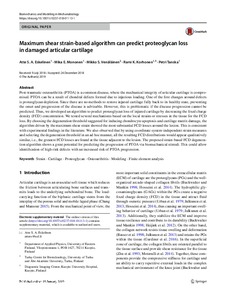Maximum shear strain-based algorithm can predict proteoglycan loss in damaged articular cartilage
Atte S.A. Eskelinen; Mika E. Mononen; Mikko S. Venäläinen; Rami K. Korhonen; Petri Tanska
https://urn.fi/URN:NBN:fi-fe2021042821839
Tiivistelmä
Post-traumatic osteoarthritis (PTOA) is a common disease, where the mechanical integrity of articular cartilage is compromised. PTOA can be a result of chondral defects formed due to injurious loading. One of the first changes around defects is proteoglycan depletion. Since there are no methods to restore injured cartilage fully back to its healthy state, preventing the onset and progression of the disease is advisable. However, this is problematic if the disease progression cannot be predicted. Thus, we developed an algorithm to predict proteoglycan loss of injured cartilage by decreasing the fixed charge density (FCD) concentration. We tested several mechanisms based on the local strains or stresses in the tissue for the FCD loss. By choosing the degeneration threshold suggested for inducing chondrocyte apoptosis and cartilage matrix damage, the algorithm driven by the maximum shear strain showed the most substantial FCD losses around the lesion. This is consistent with experimental findings in the literature. We also observed that by using coordinate system-independent strain measures and selecting the degeneration threshold in an ad hoc manner, all the resulting FCD distributions would appear qualitatively similar, i.e., the greatest FCD losses are found at the tissue adjacent to the lesion. The proposed strain-based FCD degeneration algorithm shows a great potential for predicting the progression of PTOA via biomechanical stimuli. This could allow identification of high-risk defects with an increased risk of PTOA progression.
Kokoelmat
- Rinnakkaistallenteet [27094]
